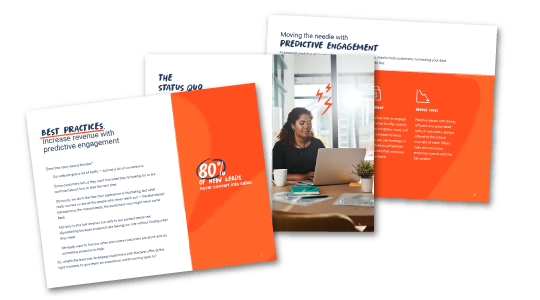Your Genesys Blog Subscription has been confirmed!
Please add genesys@email.genesys.com to your safe sender list to ensure you receive the weekly blog notifications.
Subscribe to our free newsletter and get blog updates in your inbox
Don't Show This Again.

Throughout their journeys, keeping customers well-informed and managing their expectations is key to delivering an exceptional experience. Outbound engagement — proactively reaching out to a customer — goes beyond cold calls from the sales team. It’s a critical part of any outreach strategy.
Outbound engagement could include a text reminder sent to a patient about an upcoming doctor’s appointment. Or it could be an email notifying a customer that a previously out-of-stock item is now available. Yes, it could even be that call reminding consumers about an important safety recall on their car.
Let’s take a look at the basics of outbound call center engagement, how it differs from inbound engagement and some common challenges contact centers face when trying to get it right and how doing so creates a positive customer experience.
Outbound call center engagement is a customer outreach strategy in which call centers and contact centers initiate communication to proactively engage with customers across multiple channels.
By meeting customers where they are — on the devices and channels of their choice — outbound engagement shows you listen to your customers and understand their needs. An effective outbound engagement solution can improve agent utilization and efficiency rates by between 15% and 45% improvement, shows Genesys Cloud™ benchmarking data. And those responsive and effective agents can, ultimately, improve customer satisfaction.
Modern cloud contact center technologies like automated dialers, outbound email, SMS notification systems and predictive engagement can make outbound engagement more effective. These tools make it easier to create and deliver the seamless, personalized experience customers expect.
For example, 72% of organizations globally are already using AI for outbound interactions, helping to target and personalize messaging, clarify customer intent, offer self-service, and predict optimal times to reach customers and the channels they’d prefer.

Learn how to increase conversions and revenue while providing better experiences at scale.
Inbound and outbound call center engagement differ in several ways. In outbound engagement, the contact center proactively reaches out to customers to keep them informed, guide them through their journeys and build long-term relationships. Conversely, inbound engagement is typically reactive, with customers reaching out to the contact center for answers to questions or help resolving an issue or concern.
How success is measured in each engagement type also differs. Inbound engagement commonly uses metrics such as average handling time, first-contact resolution and customer satisfaction (CSAT). Call-back rates, conversion rates and customer lifetime value (CLV) are more relevant metrics in outbound engagement.
Despite its effectiveness, outbound call center engagement still has some challenges.
Vendor dependency: Call centers become overly dependent on vendors when outbound engagement tools don’t let them create and manage their outreach with automated and/or self-service tools. This increases costs and delays lead times.
Compliance struggles: Without responsive and granular control over their outbound campaigns, call centers struggle to stay current and compliant with evolving regulatory requirements and corporate policies.
Digital myopia: Companies without outreach strategies that embrace and leverage new digital interactions — from mobile to social media, messaging apps to AI-driven bots — are missing opportunities to engage and build loyalty with customers over their preferred channels.
Modernizing and optimizing your outbound engagement with the right tools can address these challenges, improving campaign performance and enhancing customer experiences.
Offer a variety of outbound channels: To optimize communication, align available channels to customer preferences — whether that’s SMS, outbound IVR, social medial, email, self-service options and artificial intelligence (AI)-powered bots. Offering multiple channels strengthens customer relationships, increases reach, enhances financial outcomes and optimizes customer experiences.
Coordinate communication across channels: When you coordinate communication across multiple channels, data — including content and interaction history — can seamlessly pass between channels and an agent. Knowing customers’ communication preferences leads to wider reach, better campaign performance and personalized end-to-end customer experiences.
Capture and maintain customer opt-in: “Opt-in” refers to a customer’s consent for an organization to contact them through specified channels. Vendors should be able to integrate opt-in requests into existing touchpoints, create opt-in campaigns and provide automated opt-out processes for removing contacts when appropriate.
Define success and monitor outcomes: Analyze outbound campaigns and agent performance to derive insights from reports and dashboards. Then use these insights to improve overall outreach with data-driven decision-making. Measuring performance in multiple channels, however, might require different definitions of success. For example, response rates for SMS will vary from those of email, which will be different than response rates with phone calls. Develop a wider strategy that includes customer journey analytics, which examines and measures the impact of customer behavior across touchpoints.
Keep compliance in mind: Aimed at protecting the customer, regulatory requirements and internal policies rightfully set limits on outbound communication frequency and channel usage. To comply with these requirements and respond to new ones, companies need granular control over their outreach strategies. Customizing business rules for outbound campaigns, such as limiting outreach attempts and defining contact windows, can both simplify and ensure compliance.
When managed properly, outbound engagement personalizes the customer experience. Reaching out to your customers in the methods and channels they prefer show you’re listening to them and understanding their preferences and needs and taking action to help them. Offering this personalized, end-to-end and empathetic experience strengthens customer relationships and builds long-term loyalty.
Learn how Genesys can help you develop and optimize your outbound engagement strategy.
Subscribe to our free newsletter and get blog updates in your inbox.